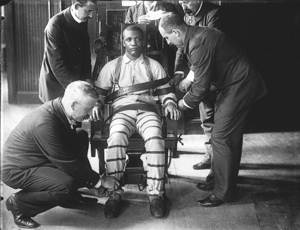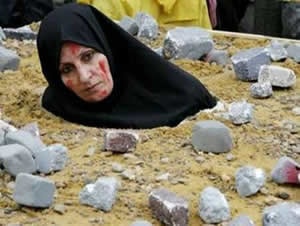 Weird Stuff
Weird Stuff  Weird Stuff
Weird Stuff  Miscellaneous
Miscellaneous 10 Things You May Not Know About the London Underground
 Books
Books 10 Great Literary Works That Almost Had Terrible Titles
 History
History 10 World Events That Made the News a Century Ago in 1925
 History
History 10 Sobering Submarine Incidents from the 1960s
 Miscellaneous
Miscellaneous 10 Words That Don’t Mean What You Think They Mean
 Space
Space Ten Mind-Bending Ideas About Black Holes
 Movies and TV
Movies and TV 10 of the Most Generation Defining Films
 Our World
Our World 10 Anomalous Fossil Finds That Stumped Scientists
 Weird Stuff
Weird Stuff 10 Amusing Tales of Lost and Stolen Celebrity Items
 Weird Stuff
Weird Stuff 10 Strange Traditions and Rituals on Transatlantic Ships
 Miscellaneous
Miscellaneous 10 Things You May Not Know About the London Underground
 Books
Books 10 Great Literary Works That Almost Had Terrible Titles
Who's Behind Listverse?

Jamie Frater
Head Editor
Jamie founded Listverse due to an insatiable desire to share fascinating, obscure, and bizarre facts. He has been a guest speaker on numerous national radio and television stations and is a five time published author.
More About Us History
History 10 World Events That Made the News a Century Ago in 1925
 History
History 10 Sobering Submarine Incidents from the 1960s
 Miscellaneous
Miscellaneous 10 Words That Don’t Mean What You Think They Mean
 Space
Space Ten Mind-Bending Ideas About Black Holes
 Movies and TV
Movies and TV 10 of the Most Generation Defining Films
 Our World
Our World 10 Anomalous Fossil Finds That Stumped Scientists
 Weird Stuff
Weird Stuff 10 Amusing Tales of Lost and Stolen Celebrity Items
Top 10 Modern Methods of Execution
We have all heard about the various methods of execution used around the world in civilized nations, but quite often we don’t know the methods involved in executing the act. With this list I hope to shed some light on the background of an execution, modern style. All but two of these methods of execution are still in use today. [WARNING: This list includes graphic images.]
1. Lethal Injection

Lethal injection room in Huntsville, Texas
In the short time before an execution by lethal injection, the prisoner is prepared for his death. This can include a change of clothing, a last meal, and a shower. The prisoner is taken to the execution chamber and two IV tubes are inserted in to his arms; a saline solution is fed through the tubes. These tubes are then fed through the wall in to an anteroom from where the execution will be carried out. The anteroom contains direct telephone connections to officials who have the power to stay the execution. Once the IV tubes are connected, the curtains are drawn back so that witnesses may watch the execution, and the prisoner is allowed to make his last statement.
Unless a stay is given, the execution begins. There can be one or more executioners, and sometimes in the case of multiple executioners, the lethal dose is given by only one so that no one knows who delivered it. The executioners are shielded from the view of the prisoner and witnesses. The drugs can be delivered by a machine, but due to the fear of mechanical failure, most US states prefer to manually inject the drugs in to the IV. The drugs are then administered in the following order:
Saline solution is used to flush the IV between each dose. Within a minute of two after the final dose is given, a doctor declares the prisoner dead. The body is then sent to the coroner for verification and sometimes an autopsy and is released to the family for burial or is buried by the state.
Need to blow off some steam? Show those flies who’s boss with BUG-A-SALT Fire Your Fly Swatter: The Original Salt Gun at Amazon.com!
2. The Electric Chair
The electric chair was invented by Harold P. Brown who was employed by Thomas Edison for the sole purpose of investigating the uses of electricity for execution. Brown, a dentist used to working with people in chairs, used a chair design for his device. At the time there was still competition to see whether Edison’s direct current (DC) or Westinghouse’s alternating current (AC) would win the current war. Edison was in favor of using his opponents AC as he thought it would lead people to believe that AC was more dangerous than DC. In fact, it would make little difference which current were used at the voltage needed for an execution. Edison was so keen to alienate Westinghouse, that he tried to get people to refer to execution by electrocution as “westinghousing” someone. The chair was first adopted in 1889 and the first execution took place in 1890 in New York.
In execution by electric chair, the prisoner is strapped to the chair with metal straps and a wet sponge is placed in his head to aid conductivity. Electrodes are placed on the head and leg to create a closed circuit. Depending on the physical state of the prisoner, two currents of varying level and duration are applied. This is generally 2,000 volts for 15 seconds for the first current to cause unconsciousness and to stop the heart. The second current is usually lowered to 8 amps. The current will normally cause severe damage to internal organs and the body can heat up to 138 °F (59 °C). While unconsciousness should occur within the first second or two, there have been occasions where it has taken much longer, leading people to speak out against this method of execution.
The post-execution cleanup is an unpleasant task as skin can melt to the electrodes and the person often loses control over bodily functions. The skin is also often burnt. The last use of the chair was on the 12th of September in Tennessee (6 days ago as of writing this). You can view a gruesome image of a person after being executed by the electric chair here.
3. Gas Chamber
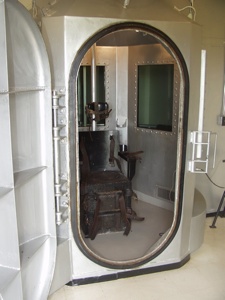
Gas chamber at Mississippi State Penitentiary
The gas chamber has been used for executions for a considerable number of years. It has gained the most notoriety from its use in the German prison camps during World War II where it was used to exterminate millions of people in one of the worst cases of genocide in the 20th century. All of the five US states that still use the gas chamber allow the prisoner to choose death by lethal injection instead. The last death by gas chamber in the US was in 1999 when German Walter LaGrand was executed in Arizona. There are unconfirmed reports that North Korea is using the gas chamber as a method of execution and to test poisonous gasses on prisoners.
Prior to the execution, the executioner will enter the chamber and place potassium cyanide (KCN) pellets into a small compartment beneath the execution chair. The prisoner is then brought in and secured to the chair. The chamber is sealed and the executioner pours a quantity of concentrated sulfuric acid (H2SO4) through a tube which leads to a holding compartment in the chair. The curtains are drawn back for witnesses to see the execution and the prisoner is asked to make his last statement. After the last statement, a level is thrown by the executioner and the acid mixes with the cyanide pellets generating lethal hydrogen cyanide (HCN) gas. The prisoners will generally have been told to take deep breaths in order to speed up unconsciousness, but in most cases they hold their breath. Death from hydrogen cyanide is painful and unpleasant.
After the prisoner is dead, the chamber is purged of gas and neutralized with anhydrous ammonia (NH3). Both the ammonia and the acid that must be removed from the chamber are highly dangerous. Guards with oxygen masks then enter the chamber and remove the body so that it can be examined by a doctor.
4. Single Person Shooting

Execution of a Vietcong captian
Execution by shooting is the most common method of execution in the world, used in over 70 countries. Whilst most of these countries use the firing squad, single person shooting is still found. In Soviet Russia, a single bullet to the back of the head was the most frequently used method of execution for military and non-military alike. This is still the main method of execution in Communist China though the gunshot can be to either the neck or head. In the past, the Chinese government would ask the family of the executed person to pay the price of the bullet. In Taiwan, the prisoner is first injected with a strong anesthetic to render him senseless and then a bullet is fired in to his heart.
5. Firing Squad
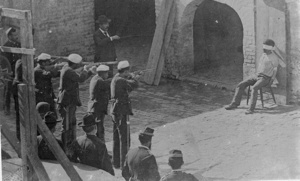
Antonio Echazarreta executed in 1913 in Mexio
The firing squad is considered by many to be the most honorable method of execution, and for that reason it was specifically not used on war criminals. While the method differs widely from country to country, generally the condemned is blindfolded and restrained. A group of men then fire a single bullet in to the heart of the prisoner. In some cases, one of the shooters is given a blank – so that afterwards he will feel less guilt. None of the shooters knows who has a blank or, in fact, if any of them do. In the most recent execution by firing squad in Utah, the brother of the executed man stated that there were five bullet holes in his brother’s shirt, indicating that every shooter fired a live round. Here is an eyewitness account of the execution of William Johnson, a deserter in the Army of the Potomac in 1861.
All being ready the Marshal waved his handkerchief as the signal, and the firing party discharged the volley. Johnson did not move, remaining in a sitting posture for several seconds after the rifles were discharged. Then he quivered a little, and fell over beside his coffin. He was still alive, however, and the four reserves were called to complete the work. It was found that two of the firing party, Germans, had not discharged their pieces, and they were immediately put in irons. Johnson was shot several times in the heart by the first volley. Each of the four shots fired by the reserves took effect in his head, and he died instantly. One penetrated his chin, another his left cheek, while two entered the brain just above the left eyebrow. He died at precisely a quarter to four o’clock.
In the United States only two states allow execution by firing squad: Idaho, and Oklahoma; though Utah still has four prisoners on death row who were sentenced when it was lawful there and they may be permitted to be executed in this way.
Get free shipping, thousands of movies, and millions of streaming songs with a FREE trial of Amazon Prime at Amazon.com!
6. Hanging
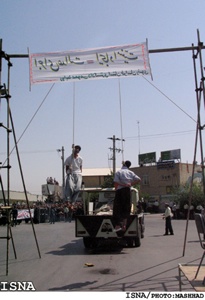
17 and 18 year old boys hanged in Iran for homosexuality
Hanging is carried out in a variety of ways: the short drop is when the prisoner is made to stand on an object which is then thrust away – leaving them to die by strangulation. This was a common method of hanging used by the Nazis and was the most common form used before the 1850s. Death is slow and painful. Suspension hanging (very popular in Iran) is when the gallows itself is movable. The prisoner stands on the ground with the noose around their neck and the gallows is then lifted in to the air, taking the prisoner with it. The standard drop was in common use in English nations after the 1850s – it involved tying the noose around the prisoner’s neck and then dropping them a short distance (usually 4-6 feet) to break the neck. This was the method used to execute the Nazi war criminals. The final method is the long drop, devised in 1872 in which the weight of a person was taken in to account to determine the correct rope and drop to be used to ensure the breaking of the neck. This was the method used by Albert Pierrepoint, the last executioner of England, described here in more detail:
The night before the execution, Pierrepoint would visit the condemned man in his cell with the Warden. The prisoner was not told that pierrepoint was his executioner. The purpose of the visit was to size the man up. Pierrepoint would use the information he had gained on the visit to decide what thickness of rope and what length of drop to use. He would soak the rope in water and would hang a sandbag the weight of the prisoner at the end to prevent stretching during the execution. The next day pierrepoint would put a cloth over the face of the prisoner and tighten the noose around his neck. He was very careful to ensure that the trapdoor beneath the condemned would be opened as soon after the noose went on as possible and would often kick the level with his foot. The person would then drop through the trapdoor and their neck would break, causing death.
There have been some instances where the long drop method has caused decapitation – the most recent of which was the hanging of Saddam Hussein’s half brother, Barzan Ibrahim al-Tikriti, in Iraq in 2007.
If you can play real audio, here is a BBC interview with Pierrepoint.
7. Beheading

Sentenced at 15, Dhahian Rakan al-Sibai’i, executed July 2007
In some nations that adhere to Islamic Sharia law, beheadings are still a commonly used method of execution. The most frequently seen cases involve beheading by a curved, single-edged sword. While many nations allow beheading by law, Saudi Arabia is the country that uses it most often. The sentence is normally carried out on a Friday night in public outside the main mosque of the city after prayers. The penalty can be dealt for rape, murder, drug related crimes, and apostasy (rejection of religious beliefs).
Saudi Arabia frequently comes under fire from international agencies because of the fact that they continue to pass this sentence on minors. Saudi Arabian officials state that they are not in breach of international law because the sentence is not carried out until the child has reached the age of 18. This was the case with Dhahian Rakan al-Sibai’i (pictured above) who was sentenced at 15 but executed this year at the age of 18.
8. Guillotine
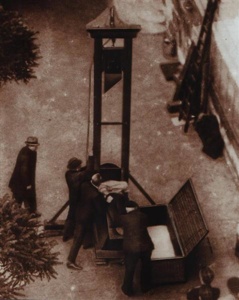
Eugène Weidmann, last public guillotine execution in France, 1939
Contrary to popular belief, Joseph-Ignace Guillotin did not invent the Guillotine; he suggested that a method of execution be devised that was quick and to be used on all people regardless of class. He sat on the committee that eventually designed the device, but it was actually Antoine Louis who came up with the design that was then used to build the first functioning guillotine. This is one of the two execution methods on this list which is no longer used anywhere in the world.
The device itself is a large timber frame with a space at the bottom for the neck of the prisoner. At the top of the machine is a large angled blade. Once the prisoner is secured, the blade is dropped, severing the head and bringing about immediate death. Much speculation exists as to whether or not the person dies immediately, and one man went so far as to ask a prisoner to blink after his head was cut off if he could. The accounts tell us that he did blink, but it is most likely that if he did, it would have been a post-death twitch.
The last public guillotining in France (photo above) was secretly filmed, and the scandalous behavior of the onlookers caused the government to ban public executions. It was the official method of execution in France until the death penalty was outlawed in 1981.
9. Stoning
Stoning to death is when a person’s movements are restricted and an organized group throws stones at them until dead. Under Islamic Sharia law, stoning is an acceptable method of execution and it is used in many Islamic nations. In Iran, stoning is sanctioned for adultery and other crimes. Article 104 of the Law of Hodoud provides that the stones should not be so large that a person dies after being hit with two of them, nor so small as to be defined as pebbles, but must cause severe injury.
“The penalty for adultery under Article 83 of the penal code, called the Law of Hodoud is flogging (100 lashes of the whip) for unmarried male and female offenders. Married offenders may be punished by stoning regardless of their gender, but the method laid down for a man involves his burial up to his waist, and for a woman up to her neck (article 102). The law provides that if a person who is to be stoned manages to escape, he or she will be allowed to go free. Since it is easier for a man to escape, this discrimination literally becomes a matter of life and death.” [Source]
Sentences to death by stoning, or stoning without a sentence have occurred in Afghanistan, Nigeria, Iran, Pakistan, Sudan, Saudi-Arabia and the United Arab Emirates in recent years, according to the International Society of Human Rights. Videos of recent stonings have been smuggled out of Iran. You can watch them here. The most recent stoning in Iran was in 2007 when Jaffar Kiani was stoned to death for adultery.
10. Garrote
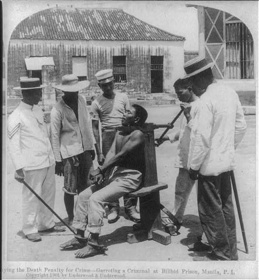
1901 execution by garotte in Manila
The garrote is the second method of execution on this list which is no longer sanctioned by law in any country though training in its use is still carried out in the French Foreign Legion. The garrote is a device that strangles a person to death (as in the photograph above). It can also be used to break a person’s neck. The device was used in Spain until it was outlawed in 1978 with the abolition of the death penalty. It normally consisted of a seat in which the prisoner was restrained while the executioner tightened a metal band around his neck until he died. Some versions of the garrote incorporated a metal bolt which pressed in to the spinal chord, breaking the neck. This spiked version is known as the Catalan garrote. The last execution by garrote was José Luis Cerveto in October 1977. Andorra was the last country in the world to outlaw its use, doing so in 1990.
Technorati Tags: crime, death penalty, execution
